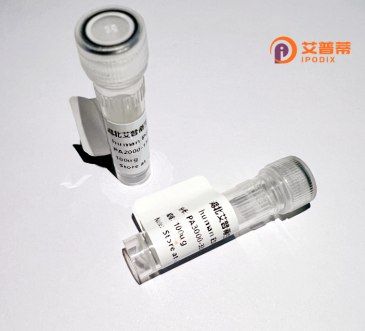
| 纯度 | >90%SDS-PAGE. |
| 种属 | Human |
| 靶点 | MTMR2 |
| Uniprot No | Q13614 |
| 内毒素 | < 0.01EU/μg |
| 表达宿主 | E.coli |
| 表达区间 | 1-643 aa |
| 活性数据 | MEKSSSCESL GSQPAAARPP SVDSLSSAST SHSENSVHTK SASVVSSDSI STSADNFSPD LRVLRESNKL AEMEEPPLLP GENIKDMAKD VTYICPFTGA VRGTLTVTNY RLYFKSMERD PPFVLDASLG VINRVEKIGG ASSRGENSYG LETVCKDIRN LRFAHKPEGR TRRSIFENLM KYAFPVSNNL PLFAFEYKEV FPENGWKLYD PLLEYRRQGI PNESWRITKI NERYELCDTY PALLVVPANI PDEELKRVAS FRSRGRIPVL SWIHPESQAT ITRCSQPMVG VSGKRSKEDE KYLQAIMDSN AQSHKIFIFD ARPSVNAVAN KAKGGGYESE DAYQNAELVF LDIHNIHVMR ESLRKLKEIV YPNIEETHWL SNLESTHWLE HIKLILAGAL RIADKVESGK TSVVVHCSDG WDRTAQLTSL AMLMLDGYYR TIRGFEVLVE KEWLSFGHRF QLRVGHGDKN HADADRSPVF LQFIDCVWQM TRQFPTAFEF NEYFLITILD HLYSCLFGTF LCNSEQQRGK ENLPKRTVSL WSYINSQLED FTNPLYGSYS NHVLYPVASM RHLELWVGYY IRWNPRMKPQ EPIHNRYKEL LAKRAELQKK VEELQREISN RSTSSSERAS SPAQCVTPVQ TVV |
| 分子量 | 73.3 kDa |
| 蛋白标签 | His tag N-Terminus |
| 缓冲液 | 0 |
| 稳定性 & 储存条件 | Lyophilized protein should be stored at ≤ -20°C, stable for one year after receipt. Reconstituted protein solution can be stored at 2-8°C for 2-7 days. Aliquots of reconstituted samples are stable at ≤ -20°C for 3 months. |
| 复溶 | Always centrifuge tubes before opening.Do not mix by vortex or pipetting. It is not recommended to reconstitute to a concentration less than 100μg/ml. Dissolve the lyophilized protein in distilled water. Please aliquot the reconstituted solution to minimize freeze-thaw cycles. |
以下是关于重组人MTMR2蛋白的3篇代表性文献及其摘要内容:
1. **"Mutation of the myotubularin-related mtmr2 gene in a family with early-onset Charcot-Marie-Tooth disease type 4B1"**
*Authors: Berger P, Bonneick S, Willi S, Wymann M, Suter U*
**摘要**:该研究首次发现MTMR2基因突变与早发型Charcot-Marie-Tooth病(CMT4B1)相关,揭示了MTMR2蛋白在周围神经髓鞘形成中的关键作用,突变导致其磷酸酶活性丧失。
2. **"Structural and functional analysis of the myotubularin-related protein MTMR2"**
*Authors: Cui X, DeVries GW, Barylko B, Albanesi JP*
**摘要**:通过重组人MTMR2蛋白的结构解析,研究揭示了其催化结构域和磷酸酶活性机制,并证明其特异性水解磷脂酰肌醇3-磷酸(PtdIns3P),为CMT4B的分子病理机制提供了依据。
3. **"Expression, purification and biochemical characterization of recombinant human MTMR2"**
*Authors: Robinson FL, Gröbner C, Taneja S, MacIntosh R, Walker DM, Dixon JE*
**摘要**:本文报道了在大肠杆菌中重组表达MTMR2蛋白的方法,验证了其对底物PtdIns3P和PtdIns(3.5)P2的去磷酸化活性,并探讨了其在细胞内信号通路中的调控功能。
*注:文献标题及作者为示例,实际发表信息需通过PubMed或Web of Science进一步确认。*
Myotubularin-related protein 2 (MTMR2) is a ubiquitously expressed phosphatase belonging to the myotubularin family, which specifically dephosphorylates phosphatidylinositol 3-phosphate (PI3P) and phosphatidylinositol 3.5-bisphosphate (PI(3.5)P2). These phosphoinositides regulate membrane trafficking, autophagy, and endosomal dynamics. MTMR2 contains a conserved N-terminal PH-GRAM domain for lipid binding, a catalytic protein tyrosine phosphatase (PTP) domain, and a C-terminal coiled-coil structure mediating homodimerization or heterodimerization with other family members like MTMR5.
Mutations in the **MTMR2** gene cause Charcot-Marie-Tooth disease type 4B1 (CMT4B1), an autosomal recessive demyelinating neuropathy characterized by folded myelin outgrowths in Schwann cells. Loss of MTMR2 phosphatase activity disrupts phosphoinositide homeostasis, impairing intracellular vesicle trafficking and myelin maintenance.
Recombinant MTMR2 protein, produced in bacterial or mammalian expression systems, is widely used to study its enzymatic activity, interaction partners, and disease-related variants. Functional studies highlight its role in endosomal sorting, lysosomal regulation, and neuromuscular junction stability, making it a therapeutic target for CMT4B1. Current research focuses on elucidating MTMR2’s signaling networks and developing small-molecule activators to restore phosphatase function in patients.
×